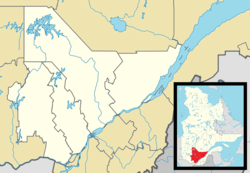L'Épiphanie: Difference between revisions
| Line 88: | Line 88: | ||
|2011_median_age=36.8 | 2011_median_age_m=36.3 | 2011_median_age_f=37.2 |
|2011_median_age=36.8 | 2011_median_age_m=36.3 | 2011_median_age_f=37.2 |
||
|2011_total_pvt_dwell=2,110 | 2011_mean_hh_income=32,704 | 2011_access_date=2022-04-01 |
|2011_total_pvt_dwell=2,110 | 2011_mean_hh_income=32,704 | 2011_access_date=2022-04-01 |
||
|notes= |
|||
|notes= Counts have been adjusted to reflect 2001 Census boundaries. <br> Population in 1996: 6,653<ref name="sc1996">{{cite web|url=http://www12.statcan.gc.ca/english/census01/info/census96.cfm |title=Electronic Area Profiles |publisher=Statistics Canada |work=[[Canada 1996 Census]] |access-date=2014-01-28}}</ref> (+0.2% from 1991) - Population in 1991: 6,637<ref name="sc1996"/> |
|||
}} |
}} |
||
Revision as of 21:05, 1 April 2022
L'Épiphanie | |
|---|---|
 | |
 Location within L'Assomption RCM. | |
| Coordinates: 45°51′N 73°29′W / 45.850°N 73.483°W[1] | |
| Country | Canada |
| Province | Quebec |
| Region | Lanaudière |
| RCM | L'Assomption |
| Constituted | June 30, 1967 |
| Government | |
| • Mayor | Benoit Verstraete |
| • Federal riding | Montcalm |
| • Prov. riding | L'Assomption |
| Area | |
| • Total | 58.17 km2 (22.46 sq mi) |
| • Land | 56.57 km2 (21.84 sq mi) |
| Population | |
| • Total | 8,883 |
| • Density | 157/km2 (410/sq mi) |
| • Pop 2016–2021 | |
| • Dwellings | 3,695 |
| Time zone | UTC−05:00 (EST) |
| • Summer (DST) | UTC−04:00 (EDT) |
| Postal code(s) | |
| Area code(s) | 450 and 579 |
| Highways | |
| Website | www |
L'Épiphanie (French pronunciation: [lepifani]) is a town in Lanaudière, Quebec, Canada. It has about 4,000 inhabitants and was 150 years old in 2004. Its located on the bank of the L'Achigan river.
On May 23, 2018, the town was enlarged when the Parish Municipality of L'Épiphanie was added to it.[4]
Name
Since 1732, the place was known as L'Achigan, thus taking the name of the river flowing through its territory. It was not until 1853 that the name L'Épiphanie appeared. This coincided with the moment of the canonical establishment of the parish, which had just separated from L'Assomption. Historians generally agree to see in this name the transposition of a Sulpician custom. They were owners of the Saint-Sulpice seigneury within which a large part of the territory of L'Épiphanie was included. On January 6 of each year, the day of the Epiphany, the Sulpicians came to celebrate a mass and took advantage of it to collect the seigniorial rents which were due to them. Ignace Bourget, Bishop of Montreal from 1840 to 1876, would have liked to recall this custom by retaining the name L'Épiphanie.[5]
Demographics
Population
| 2016 | 2011 | |
|---|---|---|
| Population | 5,495 (-2.6% from 2011) | 5,353 (+16.2% from 2006) |
| Land area | 2.30 km2 (0.89 sq mi) | 2.26 km2 (0.87 sq mi) |
| Population density | 2,387.4/km2 (6,183/sq mi) | 2,367.9/km2 (6,133/sq mi) |
| Median age | 36.5 (M: 35.4.7, F: 37.6) | 36.8 (M: 36.3, F: 37.2) |
| Private dwellings | 2,240 (total) | 2,110 (total) |
| Median household income | $32,704 | $32,704 |
Mother tongue:
- English as first language: 0%
- French as first language: 96.5%
- English and French as first language: 1%
- Other as first language: 2.5%
See also
References
- ^ "Banque de noms de lieux du Québec: Reference number 35560". toponymie.gouv.qc.ca (in French). Commission de toponymie du Québec.
- ^ a b "Ministère des Affaires municipales et de l'Habitation".
- ^ a b Statistics Canada 2021 Census - L'Épiphanie census profile
- ^ "Modifications aux municipalités du Québec" (PDF). Modifications Aux Municipalités du Québec. Institut de la statistique du Québec. May 2018. ISSN 1715-6408. Retrieved 30 September 2019.
- ^ https://toponymie.gouv.qc.ca/ct/ToposWeb/fiche.aspx?no_seq=35560
- ^ "2016 Community Profiles". 2016 Canadian Census. Statistics Canada. August 12, 2021. Retrieved 2022-04-01.
- ^ "2011 Community Profiles". 2011 Canadian Census. Statistics Canada. March 21, 2019. Retrieved 2022-04-01.
- ^ "2006 Community Profiles". 2006 Canadian Census. Statistics Canada. August 20, 2019.
- ^ "2001 Community Profiles". 2001 Canadian Census. Statistics Canada. July 18, 2021.

